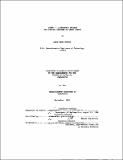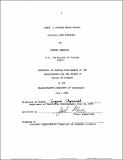Browsing MAC Technical Reports (1963 - 1974) by Title
Now showing items 1-20 of 119
-
An Abstract Model of a Research Institute: Simple Automatic Programming Approach
(1974-03)A problem of knowledge representation is considered in terms of designing a model for a simple sociological structure. A version of the access language is proposed which is based on three kind of expressions accepted by ... -
ADEPT: A Heuristic Program for Proving Theorems of Group Theory
(1966-10)A computer program, named ADEPT (A Distinctly Empirical Prover of Theorems), has been written which proves theorems taken from the abstract theory of groups. Its organization is basically heuristic, incorporating many ... -
Analysis of Asynchronous Concurrent Systems by Timed Petri Nets
(1974-02)This thesis is concerned with the modeling and performance analysis of systems which consist of concurrently acting components, an example of which is an asynchronous pipelined processor. The work is divided into two ... -
Analysis of Production Schemata by Petri Nets
(1972-02)Petri nets provide a powerful graphical tool for representing and analyzing complex concurrent systems. Properties such as hang-up freeness, determinacy, conflict, concurrency and dependency, can be represented and studied. ... -
An Analysis of Sorting Networks
(1972-10)Comparators which sort two numbers can be interconnected to form networks which sort n numbers for any n. The input and output characteristics of comparator networks are analyzed from several different points of view. -
An Analysis of Time-Shared Computer Systems
(1965-06)Some of the aspects of the operation of time-shared, interactive computer systems are analyzed. The emphasis is on the reaction of hardware systems to the demands that its users make upon it. Simply shared systems and ... -
Automatic Creation of a Code Generator from a Machine Description
(1971-05)This paper studies some of the problems involved in attaining machine independence for a code generator, similar to the language independence and the token independence attained by automatic parsing and automatic lexical ... -
Automatic Test, Configuration and Repair of Cellular Arrays
(1975-06)A cellular array is an iterative array of identical information processing machines, cells. The arrays discussed are rectangular arrays of programmable logic, in which information stored in a working cell tells the cell ... -
Autonomous, Synchronous Counters Constructed Only of J-K Flip-flops
(1972-05)This report describes research into some properties of autonomous, synchronous counters constructed with only the simplest form of J-K Flip-Flop. The research revolved around a system with a special-purpose digital machine ... -
Backup and Recovery of On-line Information in a Computer Utility
(1974-01)This thesis describes a design for an automatic backup mechanism to be incorporated in a computer utility for the protection of on-line information against accidental or malicious destruction. This protection is achieved ... -
Bounds on Information Retrieval Efficiency in Static File Structures
(1971-06)This research addresses the problem of file organization for efficient information retrieval when each file item may be accessed through any one of a large number of identification keys. The emphasis is on library problems, ... -
Calculaid: An On-line System for Algebraic Computation and Analysis
(1965-09)OPS is an on-line system developed by M. Greenberger et al. at Project MAC. The present work provides a powerful and simple way to perform numerical manipulations and calculations within OPS. The program package is called ... -
A Canonic Translator
(1967-11)An algorithm to recognize and translate sets of character strings specified by canonic system is presented. The ability of canonic systems to define the context sensitive features of strings and to specify their translation ... -
CARPS: A Program which Solves Calculus Word Problems
(1968-07-01)A program was written to solve calculus word problems. The program, CARPS (CALculus Rate Problem Solver), is restricted to rate problems. The overall plan of the program is similar to Bobrow's STUDENT, the primary ... -
Case Study in Interactive Graphics Programming: A Circuit Drawing and Editing Program for Use with A Storage-tube Display Terminal
(1969-10)The concepts involved in building and manipulating a data structure through graphical interaction are presented, using the drawing and editing of electrical circuits as a vehicle. The circuit drawings program was designed ... -
Complexity Classes of Recursive Functions
(1973-06)An honest function is one whose size honestly reflects its computation time. In 1969 Meyer and McCreight proved the "honesty theorem," which says that for every t, the t-computable functions are the same as the t'computable ... -
Complexity Measures for Language Recognition by Canonic Systems
(1970-10)A canonic system C is a specification of a recursively enumerable set, such as a set of strings over a finite alphabet. From this description C, it is possible to generate a system C , called a proof measure function, ... -
The Complexity of Finite Functions
(1972-03)Lower bounds on the length of formulas for finite functions are obtained from a generalization of a theorem of Specker. Let f: (0,1,...,d-1) [0,1,...,d-1] be a function which can be represented by a formula of length ... -
The Computational Complexity of Some Logical Theories
(1975-02)Upper and lower bounds on the inherent computational complexity of the decision problem for a number of logical theories are established. A general form of Ehrenfeucht game technique for deciding theories is developed ...



















